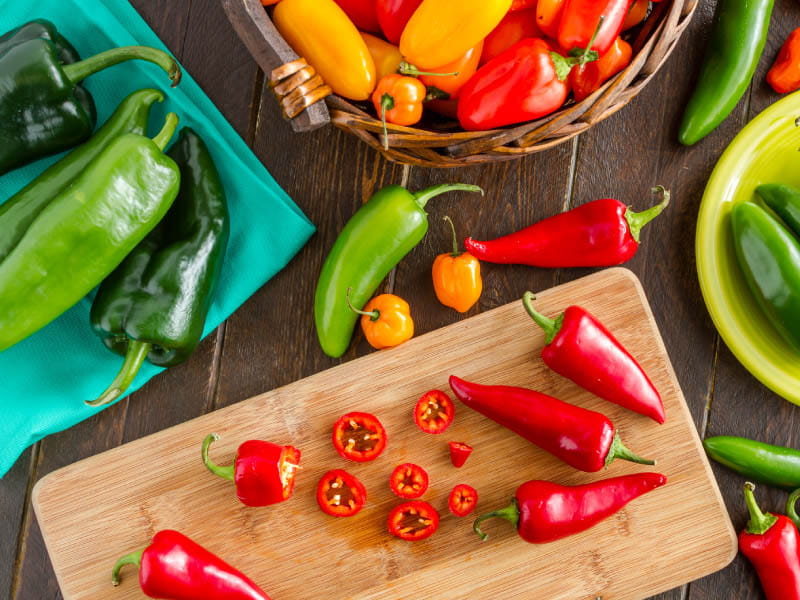Today's hot topic: Should you let chile peppers spice up your meals?
By Michael Merschel, American Heart Association News

For thousands of years, people have picked up chile peppers to provide their diets with pizazz.
There's no doubt chile peppers are packed with flavor. They also provide a little fiber without salt, sugar, saturated fat or many calories, said professor Linda Van Horn, chief of the nutrition division at Northwestern University's Feinberg School of Medicine in Chicago.
Indeed, according to the U.S. Department of Agriculture, one raw, red chile pepper – 45 grams, or about 1.6 ounces – has a mere 18 calories.
But chile peppers as a vegetable are relatively low in nutritional value, Van Horn said. "They offer a little beta carotene, but nothing comparable to carrots."
It's true that ounce for ounce, a pepper has more vitamin C than an orange. But, Van Horn said, vitamin C is typically not a nutrient of concern in the United States. And even in cultures where chiles play a larger role, other vegetables – tomatoes, onions, cabbage, kale, spinach – can be easy sources.
If you prefer your peppers as flakes or powders, be aware that raw foods tend to be more potent, nutritionally speaking, than dried versions, Van Horn said.
It's also a case where spelling matters. (More on that in a moment.) Red chile powder, or flakes, is made of dried chiles. The flakes have virtually no nutritional value.
Chili (with an "i") powder is actually a mix of red chile, other spices and salt. So although one tablespoon still provides beta carotene (which your body uses to make vitamin A), it adds 230 milligrams of sodium. The American Heart Association recommends no more than 2,300 milligrams a day, with an ideal limit of 1,500 mg for most adults.
Most commercially grown red peppers are of the species Capsicum annuum, which is nothing if not versatile. That Latin term covers hundreds of common names, including cayenne pepper but also jalapeños and Thai peppers.
The roots of modern chile peppers are tangled, with evidence that a common ancestor plant evolved in South America, then was domesticated as far back as 10,000 years ago at multiple sites across the hemisphere. Red peppers are not related to black pepper, though. For that bit of linguistic confusion, we can thank Christopher Columbus, who introduced peppers to Europe. They rapidly spread around the world from there.
Also a hot topic: How to spell "chile." The debate could fill an entire article, but the latest guidance from the Associated Press, which sets the standards for journalists, says the vegetables are "chiles."
The really burning issue with peppers is the substance capsaicin. It doesn't actually burn you, but it tricks your brain into feeling that sensation. It's what distinguishes a sweet pepper from a hot one.
It might do more. A new analysis published in the American Journal of Preventive Cardiology combined the results of previous studies on the benefits of capsaicin and found that regular consumption of chile peppers was associated with "significantly" lower rates of overall mortality, including deaths from cardiovascular disease and cancer, compared to rare or no consumption.
That review, however, attempted to draw on data from more than 4,700 scientific papers – and found only four that met the standards for inclusion. More studies are needed to identify what's happening and how it might impact adding chile peppers to your diet, the authors wrote.
Van Horn said other research has looked at capsaicin's potential use as a weight loss aid. But adding extra peppers to a Tex-Mex platter or sprinkling flakes on your orange chicken is not going to do much good, she said. Eating too many peppers, she pointed out, can even trigger an inflammatory response and stomach problems in sensitive individuals.
For her, chile peppers are best used to help add flavor to healthy things you might not otherwise enjoy. She regularly uses them in guacamole, meatless chili and other bean dishes.
"Overall, chiles should be viewed as flavorings like garlic, basil or oregano that enhance the taste of other foods but are not a meal in themselves."
If you have questions or comments about this story, please email [email protected].




